It feels like the cross-gen era is finally drawing to a close – but regardless, a range of releases continue to span two generations of console hardware – and it’s when you compare Microsoft’s powerhouse 6TF Xbox One X against today’s 4TF Xbox Series S that we see the most fascinating comparisons. We examined their performance differential in a range of games two-and-a-half years ago with a somewhat mixed outcome. However, now we’re reaching the end of cross-gen, and we have a whole new set of games to examine, which have presumably been developed with current-gen hardware more firmly in mind. And to cut to the chase, Series S is powering ahead.
Let’s start our cross-gen comparisons with Diablo 4. This highly-anticipated action RPG shipped across both last-gen and current-gen platforms last year, with excellent graphics. The basic visual comparison here is a little odd: the two platforms look largely similar, but environmental quality takes a minor hit on Xbox One X. It looks like the terrain has been simplified slightly, with a flatter, polygon-sparing look but elsewhere, the two platforms look nearly identical. Even image quality is a basic match. Both machines run at about 864p internally, with upscaling – likely FSR 2 – giving the final image a 1440p-like resolve. The game looks a touch soft on a 4K panel but holds up respectably from a normal distance I’d say, and that applies to both consoles.
Performance-wise, the One X comes in with a respectable 30fps. The game does suffer from some occasional traversal stutters though, where the player character seems to stop in place for a couple of frames. Outside of that minor blemish, it does land a stable 30 with only limited exceptions. The constant lateral movement and lack of motion blur does give the game a bit of a choppy feel though in typical play. However, Series S delivers 60fps and I vastly prefer the way Diablo 4 feels here, as it just feels so much better to control at double the frame-rate. It’s not perfect – I spotted some minor dips in cities, and some cutscenes run at an uneven update – but it is largely a smooth 60fps experience and those stutters I noticed on One X weren’t apparent here, at least to my eyes.
This is a pretty extreme best case scenario for the Series S, operating with better visual settings and double the frame-rate of its last-gen One X counterpart. On the one hand, I doubt Blizzard is taking proper advantage of the One X from a GPU perspective, but I also think that the 60fps target on Series S would have been difficult to achieve on the One X’s Jaguar CPU even with a lot of developer attention.
Next up is Assassin’s Creed Mirage, last year’s back-to-basics AC adventure. There are a few downgrades on the One X here, with reduced texture quality, some missing texture assets, somewhat simplified lighting, and more basic foliage animation. However, the One X does fight back with higher shadow resolution and a much higher rendering resolution. The One X clocks in at about 1728p or so on average, while the Series S comes in at a dynamic 1080p in its default frame-rate mode.
Performance-wise, we do manage to hit and hold 60fps on Series S the vast majority of the time. There are some brief exception, and the game does annoyingly tear during these moments, but it’s generally a very smooth experience. Cutscenes also drop to 30fps, which again isn’t a big issue at all. The One X, predictably, lands with a halved frame-rate target. It’s also not perfect, with some minor drops here and there, but it does generally come in at 30fps. This feels like the more archetypical One X vs Series S title, with a basic trade-off between image quality and frame-rate across the two consoles.
Persona 3 Reload is our next title in the crosshairs. The first point of contention has to be performance on One X, which is just not good enough in my view. Reload manages a close-to-locked 30fps on One X, but with highly uneven frame-pacing, producing a jerky, uneven experience. There’s no motion blur in typical gameplay to paper things over, so you really feel that messy frame delivery from moment to moment. Series S, predictably, doubles that frame-rate target, landing a solid 60fps. Any frame-time woes are basically negligible. I couldn’t spot any dips whatsoever in typical play, meaning the game simply operates much more smoothly on Microsoft’s pint-sized current-gen console.
Reload’s Series S outing lacks the high-quality RT reflections that grace the PS5 and Series X versions, so both the S and One X are stuck with screen-space reflections. Other visual settings essentially prove a match as well. Resolution does favour the One X, coming in around 1440p versus the Series S at 1080p, but the X’s frame pacing issues make it hard to recommend.
Next up are a pair of Like A Dragon titles. Like A Dragon: Ishin! is an Unreal Engine 4 title, just like Persona 3 Reload, and there are the same performance wobbles on the Xbox One X. If anything, I’d say the game performs even more inconsistently, with near-constant frame-pacing problems in typical play. It just feels pretty rough on a pad, and again there’s no motion blur to obfuscate any frame-time hitches. With Series S, 60fps is the target and that’s what is delivered. There are drops from time to time, and camera cuts in cutscenes drop a few frames – which is also the case on the One X. However, in typical play, the game feels a world better than the One X version.
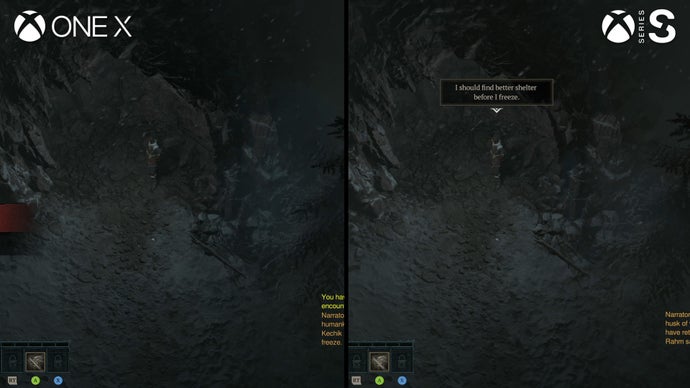
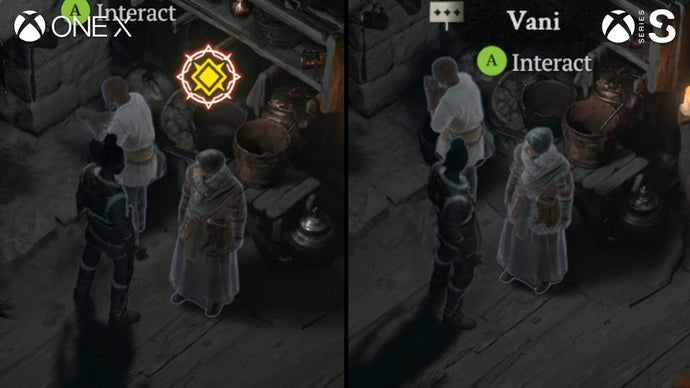
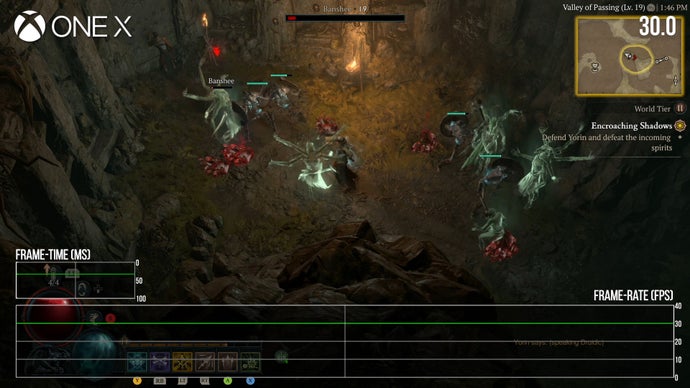
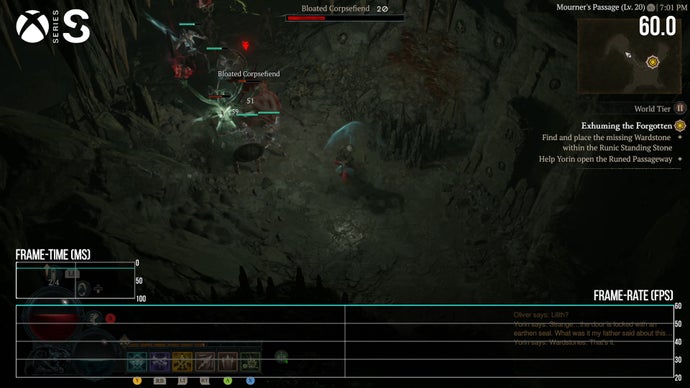
That is a pretty curious state of affairs, because along the lines of Diablo 4, both consoles land a very comparable visual presentation. I counted a typical resolution of 1080p on Series S and One X alike, with just some very minor lighting tweaks separating the two machines. Ambient occlusion does appear slightly stronger at times on the S, which I think is probably more visually pleasing on the whole. This is another case where it just feels like the Xbox One X hasn’t been given proper treatment here at all.
Like A Dragon: Infinite Wealth does show a little more visual variance between the two machines. On the surface, both consoles look nearly identical, but under the hood the One X is rendering at 1080p, while the Series S renders at just 720p. Both machines look similarly detailed in the final resolve though, which suggests some effective upsampling on Series S is likely in effect. The Series S does struggle to maintain that quality in movement, though. Xbox One X at least manages to run here with a steady 30fps, unencumbered by frame-time wobbles. This is a Dragon engine title (unlike Ishin) and isn’t afflicted by Unreal’s inconsistent frame-rate limiter, which I suspect is the issue with the earlier title. Occasionally there’s a little hiccup here and there, but it’s largely a competent 30fps experience. Series S – again – doubles the One X’s frame-rate target. 60fps is achieved on a very consistent basis, excepting some little frame-rate dips in certain cutscenes, and some occasional issues when wrapping up combat encounters.
Finally, I wanted to take a look at Wo Long: Fallen Dynasty. I’ve saved this one for last as it’s probably the least generalisable, because a lot of the faults here likely come down to Team Ninja’s proprietary tech. The Xbox One X version of the game has some of the worst frame-pacing I’ve seen in a while, feeling poor to control. Series S again pulls off the 60fps trick, but this game does a poor job maintaining it, with a steady trickle of dropped frames and some more significant stutters in the mix as well. I suspect some of the issues here likely stem from the Katana engine, which has exhibited similar problems in other games.
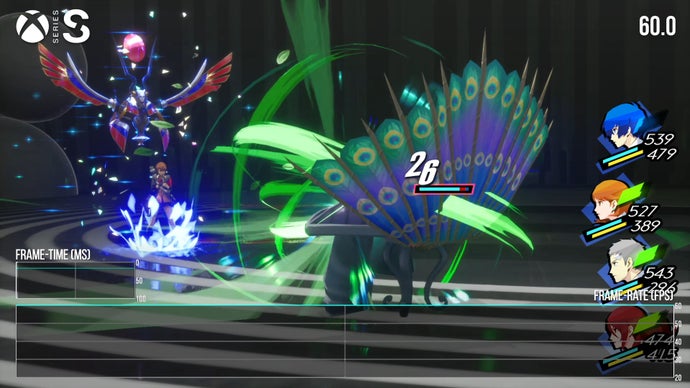
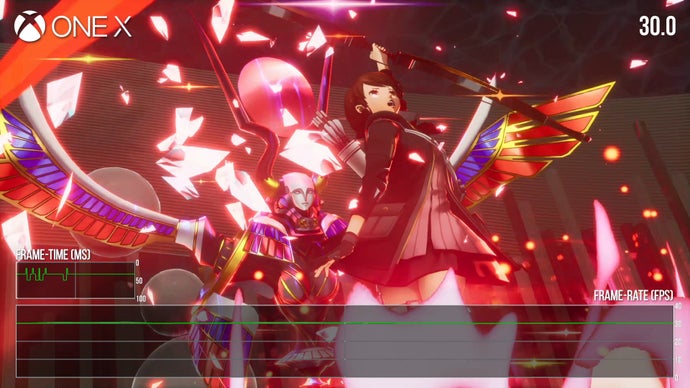
Xbox One X also suffers from seriously degraded texture quality on a wide range of surfaces, leading to a pretty poor visual outcome. The X has more memory – and memory bandwidth – than the Series S, but has much lower quality texture work regardless. Other visual settings look similar enough, and the resolution split is 900p vs 1080p, with the One X coming out on top.
The Series S and Xbox One X have wildly different storage capabilities, as the Series S features a fast SSD and has hardware decompression and a modern Zen 2 CPU. The One X packs a 5400 RPM laptop hard drive instead, with a tiny fraction of the Series S’ sequential read capability, coupled with weak netbook-class Jaguar CPU cores. The difference in loading speeds can be quite stark. Infinite Wealth takes about five seconds to go from menu to gameplay on Series S, with the One X clocking in at 33 seconds. In Wo Long, we’re looking at 19 seconds on the Series S, and about 70 seconds on the One X. A pretty broad swathe of the games we’ve tested typically take around three times longer to load on Xbox One X over Series S, which is quite substantial.
I don’t expect that any of these games are really taking full advantage of the decompression hardware that the Series S has to offer, as many current-gen only titles load even faster. And games that are fundamentally built around current-gen storage paradigms can load a lot more data into memory a lot more quickly, which is going to be reflected in the overall game experience more than in a simple loading time metric. Still, the loading differences can be quite dramatic, even in cross-gen software.
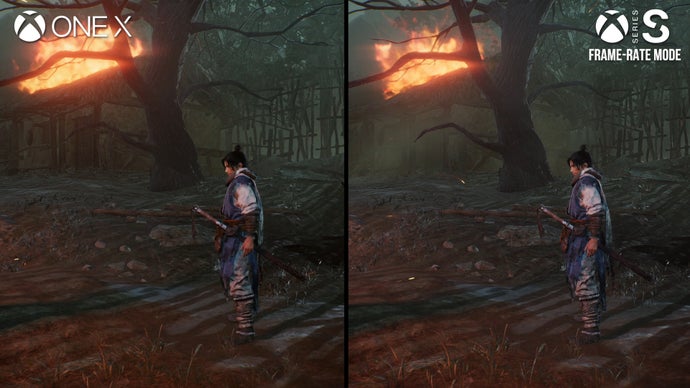
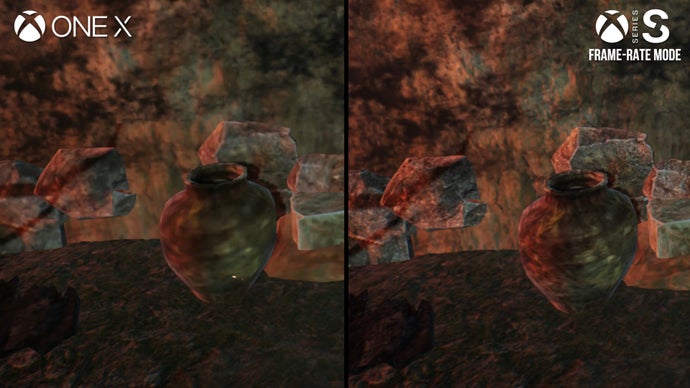
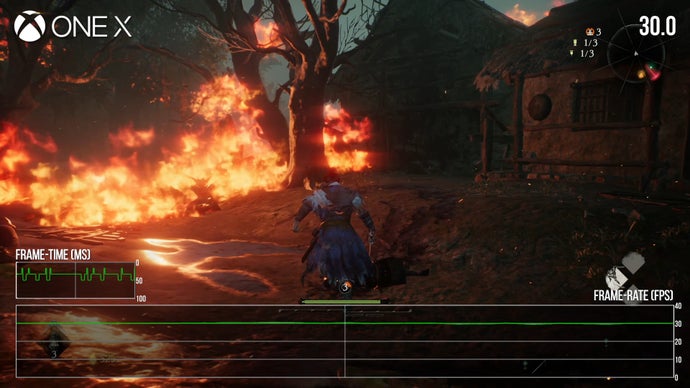
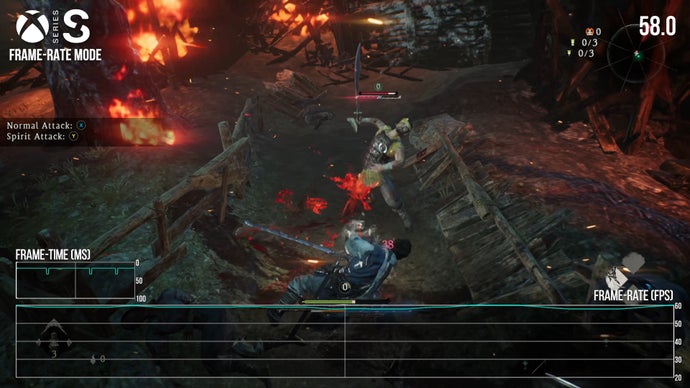
Of the games we’ve seen today, I think there are some clear patterns. Perhaps the most obvious takeaway is that the Series S’ improved CPU makes an enormous difference in most titles. There are 60fps targets in virtually every piece of cross-gen software, delivering a level of fluidity that last-gen consoles simply can’t match. The Series S’ Zen 2 cores – and PCIe SSD – are the two key pieces of tech that give the machine the upper hand in a lot of the comparisons we’ve looked at today, even with cross-gen games that aren’t built to really maximise current-gen tech.
The other discovery is that a good number of recent Xbox One X titles seem to treat the system as an afterthought. Most of the games here just provide a substandard experience, with the Series S sometimes delivering superior visuals at twice the frame-rate – a bizarre situation considering the One X’s GPU grunt. This doesn’t have a lot to do with underlying tech, but does reflect a lack of care and attention paid to the 6TF machine, and probably last-gen consoles more broadly. A solid majority of sales nowadays are bound to be made on current-gen consoles and PCs, and that’s where developer efforts seem to be concentrated. It’s also worth remembering that Xbox One development has to include Xbox One S consoles too – and we’ve sometimes seen unfortunate cutbacks not found on PlayStation manifest on the more powerful Xbox One X.
When we did these comparisons two and a half years ago, I found that the One X was a lot more competitive with the Series S. Titles like Forza Horizon 5 worked great on both machines, and some games objectively fared far better on the One X. However, looking at the state of play in mid-2024, it seems clear that the One X is getting left behind. I think all the games tested today are clearly better on the Series S, with the possible exception of Assassin’s Creed Mirage. The One X versions typically don’t maximize the potential of the console, and often come saddled with performance woes – including lengthy load times.
Besides, a huge proportion of recently released games are exclusive to current-gen machines. Just scrolling through my library, recent Xbox heavy hitters like Hellblade 2, Dragon’s Dogma 2, Final Fantasy 14, Skull and Bones, Suicide Squad, and Baldur’s Gate 3 have no last-gen Xbox version. In some cases, a last-gen Xbox version may simply lie beneath the threshold for commercial viability, like with FF14 or Resident Evil 4.
However, an increasing volume of games are genuinely harnessing current-gen features – like ray tracing, greatly improved CPU performance, and fast storage – to deliver experiences that are simply out of reach for a One X. It doesn’t matter so much that a Series S has a small GPU, what matters is that it reaches a certain key baseline of functionality for current-gen games. That’s criteria that the ageing One X simply cannot meet.
So the Xbox Series S provides a categorically better experience than the One X in 2024. It may not be the fastest console out there, but it does provide a better experience than the One X in cross-platform games. Going forward, it might be instructional to repeat these tests with PlayStation – where one might imagine that the vast installed base warrants more care and attention – and also to re-test the perennial titles like Fortnite, Call of Duty and GTA5, that still command a huge audience on last-gen hardware. For triple-A though, the writing is on the wall based on today’s testing – and it’s time to upgrade.
